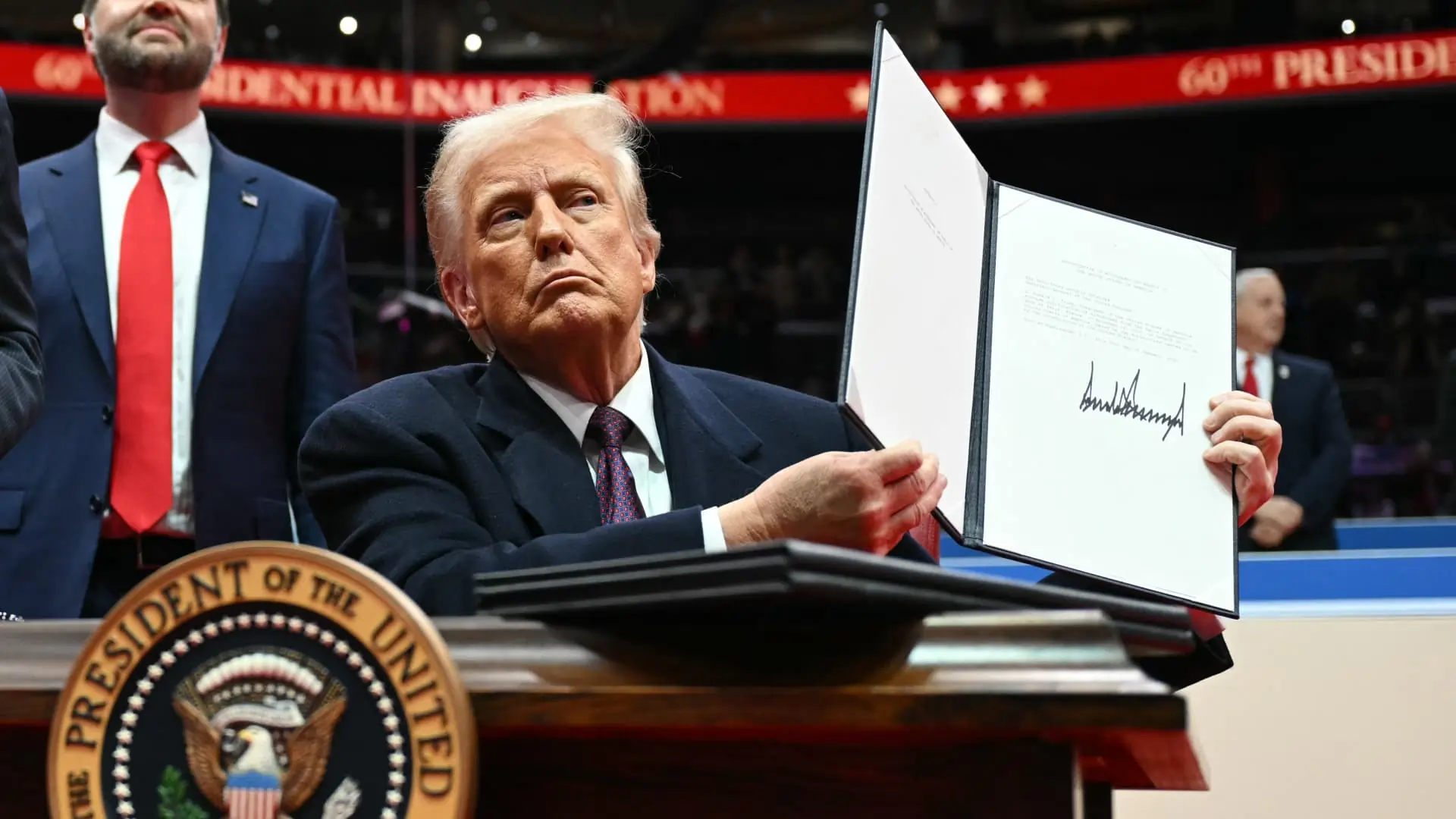For the second time in his political career, US President Donald Trump has initiated the process of withdrawing the United States from the Paris Agreement, a landmark global accord designed to combat climate change. Announced during his inauguration, this decision has reignited global debates over America’s role in climate action and the future of global environmental policies.
What is the Paris Climate Agreement?
The Paris Agreement, adopted in 2015, is a legally binding international treaty on climate change signed by 196 countries. Its primary goal is to limit global warming to below 2 degrees Celsius (3.6 degrees Fahrenheit), with efforts to cap it at 1.5 degrees Celsius compared to pre-industrial levels. To achieve this, nations commit to reducing greenhouse gas emissions, transitioning to renewable energy sources, and providing financial support to developing countries for sustainable energy development.
The United States, being one of the world’s largest emitters of greenhouse gases, plays a critical role in meeting these targets. Its participation not only strengthens global efforts but also sets a benchmark for other countries.
Trump’s Justification for Withdrawal
President Trump’s rationale for withdrawing from the Paris Agreement centers around economic priorities and energy independence. During his inauguration speech, he declared, “America will be a manufacturing nation once again, and we have something that no other manufacturing nation will ever have—the largest amount of oil and gas of any country on Earth. We will drill, baby, drill.”
Trump has repeatedly argued that the agreement imposes undue financial burdens on the United States, particularly through its commitment to contribute billions to the $100 billion annual climate fund designed to assist developing nations in their energy transitions. He also opposes carbon taxes and penalties, which he views as detrimental to domestic industries.
Economic and Geopolitical Implications
Domestic Energy Policy
Trump’s administration has historically prioritized fossil fuel production, viewing it as a cornerstone of energy security and economic growth. This strategy includes removing regulatory barriers, expanding oil and gas exploration, and investing in infrastructure projects such as pipelines.
However, critics argue that this approach overlooks the long-term economic and environmental benefits of renewable energy. Investments in wind, solar, and battery storage technologies are not only reducing energy costs but also creating jobs in emerging sectors.
International Relations and Trade
By withdrawing from the Paris Agreement, the United States risks straining its relationships with allies committed to climate action. The European Union, for instance, has expressed disappointment in Trump’s decision. EU Climate Commissioner Wopke Hoekstra called it “a truly unfortunate development,” emphasizing the need for collective global efforts.
Additionally, the EU’s proposed Carbon Border Adjustment Mechanism (CBAM) could impose taxes on imports from countries without stringent carbon regulations. This policy aims to level the playing field for European industries adhering to stricter emission standards. If enforced, US exports could face significant tariffs, potentially escalating trade tensions.
Impact on Global Climate Goals
The Role of the US in Global Emissions
The United States is the world’s second-largest emitter of greenhouse gases, accounting for approximately 16% of global emissions in 2023. China leads with over 30%, followed by the European Union and India at 9% each.
Given its significant contribution to global emissions, the US’s withdrawal undermines the collective ambition of the Paris Agreement. Without its participation, achieving the 1.5-degree Celsius target becomes increasingly challenging.
Momentum in Renewable Energy
Despite Trump’s stance, renewable energy growth in the US remains strong. Under the Biden administration, the Inflation Reduction Act (IRA) catalyzed investments in clean energy, with $270 billion allocated for tax credits and incentives. As of 2024, these initiatives had already spurred $215 billion in private sector investments.
The Energy Information Administration (EIA) projects that solar and wind energy will dominate new electricity generation in the US by 2026, reflecting a broader global shift toward renewables.
Challenges to Trump’s Energy Policies
State-Level Autonomy
Many US states have implemented their own renewable energy mandates and climate goals. California, for example, aims to achieve 100% clean electricity by 2045, while New York targets a 70% renewable energy share by 2030. These state-level initiatives could counteract federal policies promoting fossil fuels.
Market Forces and Public Opinion
Renewable energy has become the cheapest source of electricity in many parts of the world, including the US. This economic advantage, coupled with growing public support for climate action, poses challenges to Trump’s efforts to revive coal and expand oil production.
Global Reactions and Strategic Implications
China’s Position
China, the world’s largest emitter, expressed concern over the US withdrawal. In a statement, its Foreign Ministry emphasized the importance of collective action, noting that “climate change is a common challenge facing all of humanity. No country can stay out of it.”
China has positioned itself as a leader in renewable energy, investing heavily in solar, wind, and electric vehicle technologies. The US’s absence from the Paris Agreement could allow China to further dominate the clean energy sector.
Russia’s Role
The US’s focus on expanding liquefied natural gas (LNG) exports aligns with its strategy to displace Russia as Europe’s primary energy supplier. By reducing Europe’s dependence on Russian gas, the US aims to weaken Russia’s economic leverage and bolster its geopolitical influence.
The Bigger Picture: Energy Transition and Climate Resilience
While Trump’s withdrawal from the Paris Agreement represents a step backward for US climate policy, it is unlikely to derail the global energy transition entirely. The International Energy Agency (IEA) predicts that renewables will account for two-thirds of electricity generation in developed economies by 2030.
However, challenges remain. As renewable energy adoption increases, so does the need for advanced storage solutions and grid infrastructure to manage intermittent power supply. These technological hurdles must be addressed to ensure a smooth transition to a low-carbon future.
Conclusion: A Divided Path Forward
President Trump’s decision to withdraw the US from the Paris Agreement reflects a broader debate over economic priorities and environmental responsibilities. While his administration focuses on fossil fuels and energy independence, market trends and state-level policies continue to drive renewable energy growth.
The global response to Trump’s policies underscores the interconnectedness of climate action. As nations grapple with the dual challenges of economic development and environmental sustainability, the need for collective solutions becomes ever more apparent.
The coming years will determine whether the US’s departure from the Paris Agreement is a temporary setback or a turning point in the fight against climate change. For now, the world watches as the balance between political will and market forces shapes the future of energy and climate policy.
Ready to take your career to the next level? Join our dynamic courses: ACCA, HESI A2, ATI TEAS 7 , HESI EXIT , NCLEX – RN and NCLEX – PN, Financial Literacy!🌟 Dive into a world of opportunities and empower yourself for success. Explore more at Serrari Ed and start your exciting journey today! ✨
photo source: Google
By: Montel Kamau
Serrari Financial Analyst
22nd January, 2025
Article, Financial and News Disclaimer
The Value of a Financial Advisor
While this article offers valuable insights, it is essential to recognize that personal finance can be highly complex and unique to each individual. A financial advisor provides professional expertise and personalized guidance to help you make well-informed decisions tailored to your specific circumstances and goals.
Beyond offering knowledge, a financial advisor serves as a trusted partner to help you stay disciplined, avoid common pitfalls, and remain focused on your long-term objectives. Their perspective and experience can complement your own efforts, enhancing your financial well-being and ensuring a more confident approach to managing your finances.
Disclaimer: This article is for informational purposes only and does not constitute financial advice. Readers are encouraged to consult a licensed financial advisor to obtain guidance specific to their financial situation.
Article and News Disclaimer
The information provided on www.serrarigroup.com is for general informational purposes only. While we strive to keep the information up to date and accurate, we make no representations or warranties of any kind, express or implied, about the completeness, accuracy, reliability, suitability, or availability with respect to the website or the information, products, services, or related graphics contained on the website for any purpose. Any reliance you place on such information is therefore strictly at your own risk.
www.serrarigroup.com is not responsible for any errors or omissions, or for the results obtained from the use of this information. All information on the website is provided on an as-is basis, with no guarantee of completeness, accuracy, timeliness, or of the results obtained from the use of this information, and without warranty of any kind, express or implied, including but not limited to warranties of performance, merchantability, and fitness for a particular purpose.
In no event will www.serrarigroup.com be liable to you or anyone else for any decision made or action taken in reliance on the information provided on the website or for any consequential, special, or similar damages, even if advised of the possibility of such damages.
The articles, news, and information presented on www.serrarigroup.com reflect the opinions of the respective authors and contributors and do not necessarily represent the views of the website or its management. Any views or opinions expressed are solely those of the individual authors and do not represent the website's views or opinions as a whole.
The content on www.serrarigroup.com may include links to external websites, which are provided for convenience and informational purposes only. We have no control over the nature, content, and availability of those sites. The inclusion of any links does not necessarily imply a recommendation or endorsement of the views expressed within them.
Every effort is made to keep the website up and running smoothly. However, www.serrarigroup.com takes no responsibility for, and will not be liable for, the website being temporarily unavailable due to technical issues beyond our control.
Please note that laws, regulations, and information can change rapidly, and we advise you to conduct further research and seek professional advice when necessary.
By using www.serrarigroup.com, you agree to this disclaimer and its terms. If you do not agree with this disclaimer, please do not use the website.
www.serrarigroup.com, reserves the right to update, modify, or remove any part of this disclaimer without prior notice. It is your responsibility to review this disclaimer periodically for changes.
Serrari Group 2025












